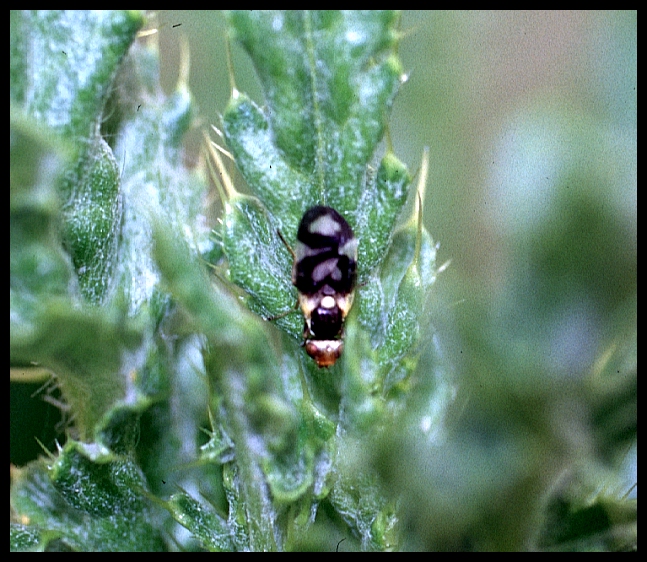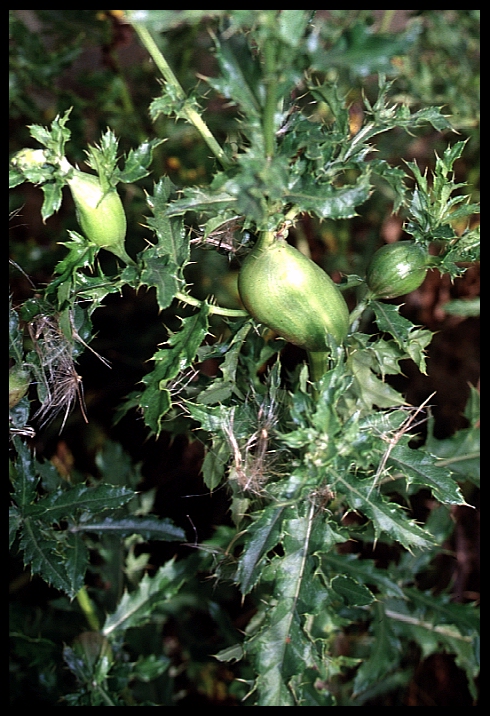Urophora cardui
Canada thistle gall fly
(Diptera: Tephritidae)


Left:
Urophora Cardui adult fly
Right: Galls caused by Urophora Cardui larvae
on Canada thistle stems.
Photos from: Dr. Alec McClay Alberta
Research Council, [website] Crop and Plant Management Unit Biological
Control
of
Life Cycle: Overwintering: Urophora
Cardui
overwinters
in the third instar, mature larva, within a stem gall on Canada
thistle.
Egg Stage: One to thirty eggs
are laid in stems during the warm,
growing
season of the plant.
Larval Stage: First instar
larva stay in the egg. In the second
instar eat into the stem and cause the formation of a gall
(swelling). The
larva
grow during this time. When the insect goes to the maturation
stage,
the larva molt and achieve 98% of their body weight. That is
their
third instar. After overwintering the larva pupate and soon
appear as a fly
inside
the gall.
Pupal Stage: The larva pupate
in early spring for 24 to 35 days.
They are then reddish-brown in color and stay inside the gall.
Adult Stage: Possibly oxygen
stimulates the appearance of the adult
fly from the gall during gall deterioration. The fly enters
through
a tunnel formed from the gall to the outside. This happens during
June to October. Adult flies have black W-markings on their wings
and are about the size of a house fly. (4-5)
Damage to Host: The destruction to
the Canada thistle (Cirsium
arvense) happens in the larval stage of the Urophora Cardui.
The area damaged is the stem of the Canada thistle. A gall is formed,
size
depends on number of larvae within the gall. The gall is about
the size of a
large
marble, and becomes a woody grey-brown after frost. It is very
hard
except when wet. The stem, flowers, and leaves above the gall are
often stunted in growth or absent. (4-5)
Host Impact: The Urophora
Cardui lays its eggs on
the
stem. The eggs hatch and second instar larvae burrow into the
stems.
That causes the gall to form and continue growing. All the plants
nutrients concentrate in the gall and do not go to other places of the
plant. The plant is then too weak to fight off other dangers and
has
a stunted growth. The stem is usually too deformed to reproduce
seeds.
Therefore, thistle reproduction is stopped or slowed, but Urophora
Cardui
does
not normally kill the plant. (2-5)
Release Habitats: Urophora
Cardui should be
released
where there are no herbicides or pesticides spread. Areas with severe
winters
and summers cause difficulties for the insect. The ground should be
dense
with Canada thistle and have a source of moisture for the adult flies
such
as a lake, river, ditch, or high humidity. This insect prefers
somewhat
shaded areas. Ground areas that will be affected by mowing,
flooding,
or
overgrazing will not be a good release sites. (2-5)
Note: These flies have been released in the Whitehall area several
times (in
stream side habitat) with no evidence of establishment at this time-
3/2006.
T. Breitenfeldt
(3)
Collection, Transportation, and
Release: Collection
happens in
fall, winter, or early spring. Galls are snipped from the stems
and are
then stored in cardboard boxes or paper sacks to be refrigerated at 39
to 46 degrees Fahrenheit (4 to 8 degrees Celsius). If the
refrigerator
is ventilated, the galls should be lightly misted with water every 2 to
4 weeks to maintain a balance of moisture. Placing galls in cages
or sleeve boxes will confine the adult flies coming out so they can be
used for a mass release. Misting galls a maximum of 5 times a day
will help with the emergence. Food for the adult flies is best
provided
by soaking a sponge in sugar water and setting it in the cage.
This
form of nourishment allows the counting and sorting of flies.
Release
from 50 to 100 (or more if you have them) flies in local areas with
Canada thistle. The
thistles
should be misted with water or the flies should be released in cages
over
the plants.
Collection of adult flies can be done with a sweep net, but
results are poor. The best time to hunt for them is after a
prolonged
stormy period in the area of release. (4-5)
Redistribution: Galls can be
collected from the infested
areas
in fall, winter, or early spring, stored, and then released as adult
flies (see above).
Transportation should occur only with larvae in galls or adult flies
caught
with a sweep net. (5)
Purchasing: Contact your local county
extension office or weed district. (3)
Remarks: This insect has been
approved by the Animal and
Plant
Health Inspection service. Study shows that a combined effort of
insects, including the Urophora cardui, has reduced thistle by
as
much as 48%. The insect is not a threat to non target species,
and
the return of grasses and forbs has been seen in previously infested
areas.
(1)
Useful
Sites:
1. http://res2.agr.gc.ca/lethbridge/weedbio/agents/aurocard_e.htm
2. http://www.angelfire.com/or2/SEORNoxiousWeeds/urophoracardui.htm
3. http://extension.ag.uidaho.edu/minidoka/Stem%20Gall%20Fly%20pictures.htm
4. http://www.blackwell-synergy.com/links/doi/10.1046%2Fj.1365-294X.1997.00236.x
5. http://asuwlink.uwyo.edu/~caps/numbers.htm
6. http://www.invasiveplants.net/biologicalcontrol/17CanadaThistle.html
7. http://www.efn.org/~ipmpa/Noxcthis.html
8. http://www.landcareresearch.co.nz/research/biosecurity/weeds/cal_thistle/CalifornianThistlegallfly.asp
9. http://res2.agr.ca/lethbridge/weedbio/agents/aurocard_e.htm
10.
http://www.eap.mcgill.ca/PCBCW_1.htm
Bibliography
1) Rice, Ross and Roddy, Dan 7/22/99. [website]
Canada
Thistle Control By Insects, <>
http://www.aqd.nps.gov/pubs/yr_rvw96/chapter7/thistle.htm.
7/22/99.
2) McClay, Alec, Alberta Research Council, [website]
Crop and Plant Management Unit Biological Control of
3) Breitenfeldt, Todd, Personal interview, biology teacher, Whitehall
Schools, Box 1109, Whitehall,
MT 59759 (406) 287-3862. Sept. 1, 1999, January 21,
2005.
4) Reese, Norman, et., al., Ed., Biological Control of Rangeland Weeds
in the Northwest United States,
Manuscript/ Rough Draft. 1996.
5) Reese Norman, et., al., Ed., Biological Control of Weeds in the
West,
Western Society of Weed Science, in
cooperation with USDA, ARS, MT Dept. of Agriculture, and MT State
University,
Color World Printers, Bozeman, MT, Feb. 1996.
By WHS
Student. 9-15-99. Updated by: Paul Monforton, WHS Student.
1-21-06

